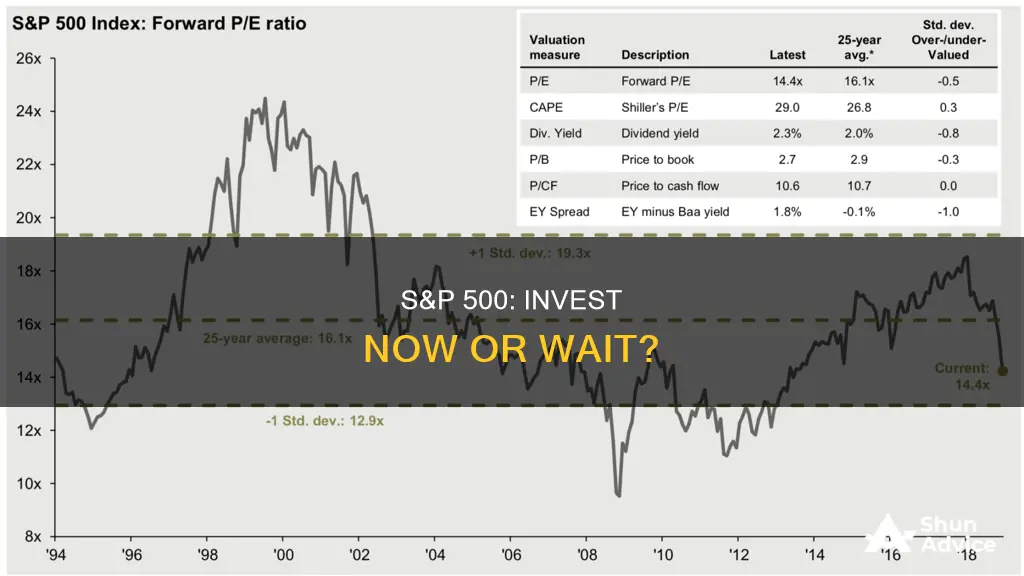
The S&P 500 is a stock market index composed of about 500 publicly traded companies. It is one of the most widely-followed stock market indices in the world and is often considered a proxy for the overall health of the U.S. stock market.
You cannot invest directly in the S&P 500 index itself. However, you can gain exposure to the index by investing in the individual stocks of the companies that comprise it or by investing in index funds or exchange-traded funds (ETFs) that track the index.
Index funds and ETFs are popular options for investors seeking to gain exposure to the S&P 500 due to their low costs, diversification benefits, and ease of use. When choosing an index fund or ETF, it is important to consider factors such as expense ratios, minimum investment requirements, dividend yields, and the fund's track record.
While investing in the S&P 500 can provide consistent long-term returns and instant diversification, it is important to keep in mind that it is dominated by large-cap companies and does not offer exposure to international companies. Additionally, the S&P 500 is subject to short-term volatility and may not be suitable for investors who cannot tolerate market downturns.
| Characteristics | Values |
|---|---|
| Number of companies | 500 |
| Type of companies | Leading U.S. companies |
| Investment options | Individual stocks, index funds, or ETFs |
| Index funds vs ETFs | ETFs can be traded throughout the day like stocks, while index funds can only be bought and sold at the end of the trading day |
| Risk | Less risky than individual stocks |
| Cost | Low |
What You'll Learn

What is the S&P 500?
The S&P 500 (Standard & Poor's 500) is a stock market index that measures the performance of about 500 large US companies. It is considered the best overall benchmark of how the US stock market is doing and is one of the most widely followed equity indices.
The S&P 500 is a statistical measure of the performance of America's 500 largest stocks by market capitalisation (share price multiplied by the number of shares). It is weighted by market capitalisation, meaning that a company's valuation determines how much influence it has over the index's performance. The larger the company, the greater its influence on the index.
The S&P 500 was created in 1957 by financial research and analysis firm Standard & Poor's. It is now maintained by S&P Dow Jones Indices, a joint venture majority-owned by S&P Global.
The S&P 500 is designed to be a barometer of a large swath of corporate America. The companies in the index comprise about 80% of the US equity market capitalisation and over 50% of the global equity market.
To be included in the S&P 500, companies must meet certain criteria. They must have a market capitalisation of at least $8.2 billion, be based in the US, be listed on an eligible US exchange, and have positive as-reported earnings over the most recent quarter and the four quarters before that added together.
The index is considered a good measure of the health of the US stock market and the broader economy. It is also used as a benchmark against which portfolio performance can be evaluated.
The easiest and most efficient way to invest in the S&P 500 is via a low-cost exchange-traded fund (ETF).
China's Bubble: Global Investment Risk
You may want to see also

How to invest in the S&P 500
The S&P 500 is a stock market index that tracks the performance of 500 of the largest U.S. public companies by market capitalization. It is not possible to directly invest in the index itself, but there are a few ways to gain exposure to the S&P 500.
S&P 500 Index Funds
Index funds that track the S&P 500 typically own most or all of the stocks included in the index so that they can mimic the performance of the index as closely as possible. They then sell shares of the fund, so investors can buy exposure to their hundreds of constituent investments.
When choosing an S&P 500 index fund, consider the following:
- Expense ratio: Index funds are passively managed, which means that the fund’s managers simply buy and sell stocks to keep the fund’s asset allocation in line with the benchmark. This keeps expense ratios, the fees you pay for the upkeep of your fund, very low.
- Minimum investment: Index funds have different investment minimums, whether you purchase them for taxable investment accounts or tax-advantaged retirement accounts.
- Dividend yield: Dividends are one of the perks of investing in the large-cap companies that make up the S&P 500. Be sure to compare the dividend yield offered by different S&P 500 index funds as dividends can boost returns, even in down markets.
- Inception date: It’s worth paying attention to an index fund’s inception date. Choices with longer histories can help you see how an index fund weathered bull markets and mitigated losses in bear markets.
S&P 500 ETFs
Like index funds, passively managed ETFs aim to duplicate the performance of a market index like the S&P 500. Managers purchase a basket of securities to duplicate the benchmark index’s holdings and then sell shares to investors.
Here’s where ETFs differ from index funds: the shares issued by an ETF trade like stocks, with values that fluctuate all day long. Meanwhile, index fund shares only trade once a day, when markets close at the end of the day.
When choosing an S&P 500 ETF, consider the following:
- Expense ratio: As with S&P 500 index funds, S&P 500 ETFs all have virtually the same performance. You should always choose the fund with the lowest expense ratio as higher costs do not guarantee better returns on the same index.
- Liquidity: Buy-and-hold investors don’t need to worry too much about ETF liquidity. But if you’re an active investor trading in a taxable brokerage account, it’s worth getting a feel for how an ETF’s liquidity could impact your strategy. Funds with higher average trading volumes are more liquid, and ones with lower trading volumes are less so.
- Inception date: The older an ETF, the more economic cycles it has been through. The more cycles of boom and bust markets a fund has experienced, the more confidence you can have about a fund’s ability to sustain performance over the long term.
- Dividend yield: Much like index funds, the dividend yield of S&P 500 ETFs represents the percentage the component companies of the benchmark index pay out annually in dividends per dollar you invest.
Individual Stocks
You can also hand-select individual stocks of companies you want to invest in. However, if you wish to track the S&P 500 exactly, you may need to purchase up to 500 different companies, which can be costly and time-consuming. Keep in mind that investing in a single company increases the risk and volatility of your investment and will require thoughtful research and stock performance analysis.
Vanguard Investors: How Many?
You may want to see also

Pros and cons of investing in the S&P 500
Pros of Investing in the S&P 500 Index
The S&P 500 Index is one of the most renowned global stock market indices, offering exposure to a wide range of leading companies across various sectors. Here are some advantages of investing in it:
- Diversification: The index includes 500 large-cap US stocks from multiple sectors, reducing the risk associated with investing in individual stocks. If some companies underperform, gains from others can offset the losses.
- Long-Term Growth: Historically, the S&P 500 has demonstrated strong long-term growth potential, consistently outperforming other investment options. While short-term fluctuations occur, the underlying trend is upward due to the growth of the US economy.
- Accessibility: The S&P 500 is accessible to a diverse range of investors through index funds, exchange-traded funds (ETFs), or mutual funds. Many brokerage platforms also offer low-cost investment options.
- Professional Management: A committee manages the index, regularly reviewing and adjusting its constituents. This provides investors with confidence in the index's composition and accuracy in representing the US large-cap stock market.
Cons of Investing in the S&P 500 Index
Despite its advantages, investing in the S&P 500 also has some potential drawbacks:
- Market Volatility: While the S&P 500 has shown long-term growth, it is susceptible to market volatility and downturns, which can lead to significant index value declines. Investors need to be prepared for short-term fluctuations.
- Lack of Individual Stock Selection: Investing in the index means giving up control over individual stock selection. While this provides diversification, it may result in missing out on potential gains from specific stocks that outperform the broader market.
- Concentration in US Stocks: The S&P 500 is heavily weighted towards US-based companies, which may limit exposure to international markets and reduce the diversification benefits of global investments.
- Inclusion of Underperforming Stocks: Despite periodic reviews, there may be instances where underperforming stocks remain in the index for extended periods, impacting overall performance.
Kodak Stock: Buy or Pass?
You may want to see also

S&P 500 vs other indexes
The S&P 500 is a stock market index composed of about 500 publicly traded companies. It is one of the most widely-followed stock market indices in the world and there are many funds that invest based on the index.
S&P 500 vs Dow Jones Industrial Average (DJIA)
The S&P 500 is often the institutional investor's preferred index due to its depth and breadth. The DJIA has historically been associated with significant equities from a retail investor's point of view. The S&P 500 is considered more representative of US equity markets because it includes more stocks across all sectors: 500 versus the Dow's 30. The S&P 500 uses a market-cap weighting method that gives a higher percentage allocation to companies with the largest market caps. The DJIA is a price-weighted index that gives companies with higher stock prices a higher index weighting.
S&P 500 vs Nasdaq Composite
Nasdaq is a global electronic marketplace for trading securities. The Nasdaq Composite Index includes more than 2,500 common stocks that trade on Nasdaq. The S&P 500 tends to be suitable as an investment for investors seeking broad exposure to the US economy.
S&P 500 vs Russell Indexes
The S&P 500 is a member of a set of indexes created by Standard & Poor's. There are two significant differences between the construction of the S&P and the Russell families of indexes. Standard & Poor's chooses constituent companies via a committee. Russell indexes use a formula to select which stocks to include. There's no name overlap within S&P style indices such as growth versus value. Russell indexes will include the same company in both the value and growth style indexes.
S&P 500 vs Vanguard 500 Fund
The Vanguard 500 Index Fund aims to track the price and yield performance of the S&P 500 Index by investing its total net assets in the stocks that make up the index. The fund barely deviates from the S&P 500 in this way, which it's designed to mimic.
Backpack Wheels: Invest in Comfort
You may want to see also

S&P 500 index funds vs S&P 500 ETFs
The S&P 500 is a stock market index composed of about 500 publicly traded companies. While you cannot invest directly in the index itself, you can buy individual stocks of companies in the S&P 500, or invest in S&P 500 index funds or ETFs.
S&P 500 Index Funds vs. S&P 500 ETFs:
Trading Mechanics
One of the fundamental differences between S&P 500 index mutual funds and S&P 500 ETFs is the way they are traded. Index funds are priced once a day and all transactions are executed at that price, whereas ETFs are traded on a stock exchange and their price fluctuates throughout the day as they are bought and sold.
Management Style
Most ETFs are considered "passive" investments because they are designed to track the performance of a particular index. They do this by owning the same securities held in the index in equal portions. In contrast, most mutual funds are actively managed, meaning a fund manager actively buys and sells securities in the hope of beating an index benchmark.
Costs and Fees
ETFs and index funds tend to have lower management fees than actively managed funds. However, ETFs may have additional costs such as commissions and the fund's operating expense ratio (OER). Mutual funds, on the other hand, carry an expense ratio and may also charge a sales fee known as a load.
Tax Efficiency
ETFs are generally more tax-efficient than mutual funds. This is because ETFs have a structural ability, called the in-kind creation/redemption mechanism, to minimize the capital gains they distribute. Mutual funds, on the other hand, may need to sell securities to raise cash when investors redeem their shares, which can trigger capital gains for all fund shareholders.
Minimum Investment
ETFs do not require a minimum initial investment and are purchased as whole shares. Mutual funds, on the other hand, usually have a minimum flat-rate initial investment and can be purchased in fractional shares.
Suitability
If you are investing inside an employer-sponsored 401(k) plan, you may have limited options, predominantly mutual funds. In this case, an index mutual fund could be a good choice due to its lower fees.
If you have access to ETFs, perhaps through a self-directed Roth IRA or a taxable brokerage account, then ETFs may be preferable if you plan on frequent trading due to their intraday trading flexibility.
On the other hand, mutual funds are a good choice for those who prefer a hands-off approach as they enable easy automation of periodic contributions.
Investments: Where is the Money Going?
You may want to see also
Frequently asked questions
The S&P 500 is a stock market index composed of about 500 publicly traded companies. It is one of the longest-standing and most popular broad stock market indexes.
You can buy individual stocks of companies in the S&P 500, or buy an S&P 500 index fund or ETF. You cannot invest directly in the index itself.
The S&P 500 offers investors a lot of diversification and exposure to some of the biggest companies in the U.S. It has historically provided consistent annual returns over the long term.
The S&P 500 is heavily weighted towards large-cap companies, particularly in the information technology sector. As such, it won't provide exposure to many small-cap or mid-cap stocks and it may be susceptible to volatility in the tech sector.
Some popular S&P 500 index funds and ETFs include:
- SPDR S&P 500 ETF Trust (SPY)
- Vanguard S&P 500 ETF (VOO)
- iShares Core S&P 500 ETF (IVV)
- Fidelity 500 Index Fund (FXAIX)
- Schwab S&P 500 Index Fund (SWPPX)







